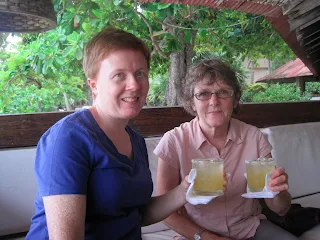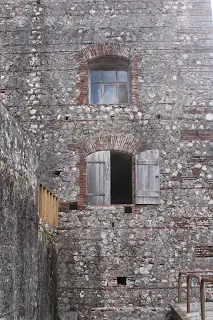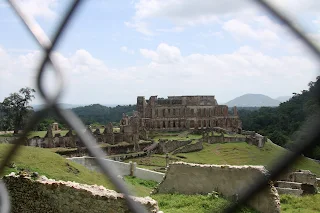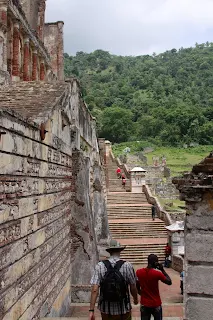In late June, my mother came to visit, and we went to the historic northern city of Cap Haitien. Cap, as it is known, is still Haiti's second city, but in colonial days it was the heart and soul of the colony. Cap remains a jumping off point for two of Haiti's most important historic ruins, the Citadelle La Ferriere and the Sans Souci palace. Both the Citadelle and Sans Souci were begun in 1805 by one of Haiti's revolutionary heroes, Henri Christophe, a freedom fighter who declared himself king and reinstated slavery shortly after the end of the revolution. It's not that he was such a bad guy, right? He just wanted to kick start the economy, and the best, cheapest, and most effective way he could think of to do that was with slave labor. He had a stroke and killed himself in 1820. After King Henri's death, the Citadelle was abandoned, and nobody really bothered it until 1974 when UNESCO decided to investigate making it a World Heritage Site. The access road was built by Jean Claude (Baby Doc) Duvalier in the mid-1980s, and UNESCO has continued with restorations in phases since the 1990s.
We stayed at a nice beach hotel out of town, Cormier Plage, and enjoyed the drinks and the dinners immensely.
In the morning, we drove to a little town called Milot where we met our tour guide. We drove (mercifully) the 7 km up up and up the mountain to the Citadelle, nearly 3000 feet above sea level. On our way back down, we passed people whose guides chose to make them ride horses up the long driveway.
Ian especially wished we could spend more time on the horses.
Check out that horse 4H mother's style on horseback!
Each of us had a team of two or three young men to "help" us with the horses. One led the horse, one followed to whack the horse with a switch periodically, and one walked along side for no apparent reason. Each of these boys needed a tip, and each was adept at begging for more. It was an unfortunate element of the trip, but it's very typical here.
The Citadelle was designed to be impressive, imposing, and daunting. You wind up a very narrow paved path (not original) to get to it, and it appears out of the hillside. When we were there, it was wrapped in clouds.
Looking down at the path from inside.
The main keep was designed to look like the prow of a boat.
Up close, the Citadelle is unbelievably huge. Bear in mind that this was built by 20,000 laborers in a human chain, passing giant boulders and rocks and non-cement binding materials up to 3000 feet elevation. The Citadelle is the largest fortress in the Caribbean.
Ian the Intrepid Horseman arrives at the top and thankfully prepares to leave his horse behind.
Our guide was very determined that we know that this piece of wood is original to the fort. It is mahogany, a valuable hardwood for which Haiti was famous (among others) before it was clearcut. This lintel has been in place since the early 1800s and has withstood the elements since then. That is, of course, our guide's hand for scale.
Also a lizard for scale.
I was there!
Looking down and to the south, roughly. You can see a meandering river in the middle left part of the photo. We are looking over the roofs of several of the principal buildings.
This is the backside of the main keep, the one that looks like the prow of a ship from the front. It has not yet been restored and is unaccessible at this time.
The approach to the entrance is still very impressive. Ian provides a nice sense of the grandeur of the place. The openings without shutters near the top of the building are cannon berths; the Citadelle was designed to provide ultimate protection in case of an invasion.
This is the roof of the infirmary. It did not look well ventilated and would probably have killed as many as it saved.
The Citadelle was built with no modern cement: builders used a mixture of locally available things to create a glue of sorts to stick all those rocks together.
It was extremely foggy on one side of the Citadelle the whole time we were there. Bits of cloud kept drifting over us, and we could not get a good view down the back side of the mountain. But it was very beautiful.
Looking back at the door through the wall. There are two official doors to get into the Citadelle, and there is a third secret door for fast escapes in case the defenses didn't hold. Our guide showed us the access to the third door, but it's not open for people to look at now. Maybe after renovations?
These next photos are from the inside, after you walk through what passes for a main door. The place is a little bit like walking into an Escher staircase fantasy, but all the different levels, turning staircases, and sudden windows are security features. Anybody entering the inner reaches of the Citadelle would be covered by soldiers at every turn. Post-revolution Haiti was a treacherous place.
The all-important kitchens! These are ovens, once used to bake basic breads for the soldiers and occupants of the Citadelle. Given the Citadelle's short time in operation, it's unclear how much the ovens were used.
More funky staircases. We climbed all the way up this one.
Windows overlooking the central courtyard of the fort.
A partial view of the central courtyard. The building with the flag on top of it is the general's quarters, and in some ways it was designed to look at French as possible (photos below). The Haitian revolution was a fascinating blend of revolution and imitation.
Ian was there too!
More windows and doors accessing the central courtyard.
Another fascinating staircase and series of arches. This is, obviously, not yet restored, so we couldn't climb up it.
This is the inside of the main keep that was built like a ship's prow. You can see that it's not yet ready for tourists!
Another view down to the river from the top of the Citadelle.
If you're planning to build a fortress on top of a mountain, you need to consider the importance of having access to water. The Citadelle is designed with an impressive water collection system and several cisterns. It is not working currently for water collection, but presumably it is part of UNESCO's restoration project. This beautiful system is on the roof (obviously the plastic bin is not original and doesn't form part of the old system!).
More water collection in a different part of the castle. This is near the other entrance; the second entrance has a portcullis and a powerful mechanism to lock down the fortress in case of attack.
Looking at the main keep shaped like a ship's prow from the back/ side. Obviously the front is pointed, not the back and sides.
Here is the front of the very European-looking general's quarters mentioned above.
And the super Frenchy guard's post.
This is part of the powder magazine in the central courtyard. It blew up and killed one of the officials while the fortress was in use.
Looking over the roof of the powder magazine to more of the buildings that make up the fortress.
"Extraordinary builder of this Citadelle, Henri Christophe killed himself in the Palace of Sans Souci on October 8, 1820. The very night he died, his body was buried in secret in the grounds of this fort, where today only the untouchable dust of the tragic remains of the disappeared monarch brush the walls invisibly. Bus it's here, however, that the daughters and the sonds of the Haitian territory come to remember, in quest of a message of historic unity of the people and of the choice of a destiny of liberties always remaining to conquer."
To this day, no one knows where Henri Christophe is buried, besides somewhere in the fortress grounds.
Ian keeping an eye on the situation.
The Citadelle was built to be a massively fortified place of safety and war, so it's bristling with cannons and ammunition. Our guide said there were 375 cannons there, and 10,000 cannon balls, but the guide books says only 163 cannons. Regardless, it's a lot of cannons and cannonballs, especially when you remember that everything was carried up by a human chain of forced labor.
These cannonballs are stacked by size to give tourists a sense of the different kinds of cannons. Most of Haiti's artillery came from capturing hostile forces, and since everyone was hostile to Haiti in the early 1800s, there are Spanish, English, and French - both pre- and post-French Revolution - cannons represented at the Citadelle.
An overview of the cannonball display near the entrance. It's a whole lot of cannonballs.
These three windows are the cannon berths I mentioned above. A cannon would be rolled up to the window, pointed, and fired if enemy activity was detected. The Citadelle was very thoroughly protected, and it was never once attacked.
This is an original cannon on its original mahogany carriage.
More cannons on their carriages. Some of these are original and some are restored. Though the photo is a bit blurry, you can see the carriage tracks in the stone floor to facilitate maneuvering the cannon into the desired position for firing. There is a very involved connection between the cannon galleries and the water system as well; I'm not up to speed on cannon-based warfare, but apparently you need water immediately after firing a cannon, and each canon berth has access to water just behind it.
N for Napoleon!
LB for Louis Bonaparte (one of Napoleon's nephews, I believe).
This cannon belonged to the Duke of Penthieure, whoever he was.
Larger shot of the decor on the Duke of Penthieure's cannon.
The rest of these cannons no doubt have fascinating stories, but I took their pictures because of the fascinating decorations on their barrels.
More cannonballs that didn't make the public piles by the entrance.
None of these cannons or weapons systems were ever used at the Citadelle because no one attacked during its time of activity. When King Henri had a stroke and killed himself in October, 1820, his army walked away from the Citadelle, and no one went back until much later. The cannons, admittedly hard to move around, were left alone and not tampered with for 150+ years.
-----------------------------------------
At the base of the Citadelle's mountain, the little town of Milot plays host to visitors to both the Citadelle and the ruins of the Sans Souci palace. Henri Christophe built Sans Souci -- "No Worries" - to rival the European palaces and to make his reign feel more powerful. He killed himself in the throne room of the palace after his stroke, allegedly with a silver bullet, in 1820. The palace stood in all its imitation splendor (and it truly was splendid) until a massive earthquake hit the area in May, 1842. Sans Souci and its outbuildings were destroyed, and the rest of King Henri's legacy was finished. The earthquake did not impact the Citadelle.
Sans Souci, viewed from the front.
Sans Souci, viewed from the road that climbs to the Citadelle. This is the view towards the throne room, possibly considered the ceremonial front of the palace. The smaller ruins are the palace's outbuildings - barracks, stables, storerooms, etc.
Ruins.
The view from the throne room across the side rooms to the grassy court beyond.
The guide wouldn't let me climb this staircase, wonder why? It looks pretty shaky and appears to be bricks floating with no support other than themselves. And there does not appear to be a supporting arch structure....
Looking back through the throne room and its wings from the grassy court. The palace was four storeys in its heyday, and it was decorated with the finest and most pompous items available to King Henri. There are still bits of stucco on some of the walls; our guide un-ironically pulled a bit down to show us it was still there.
A lovely Italianate marble bust in the courtyard. This may or may not be Henri's wife, Maria Louisa. The books say one thing, and they guides say another. All the same, she's lovely.
The front of the throne room. It's nearly impossible to get a good shot because the foundations are crumbling and there are few places sturdy enough to stand.
The vehicle front of the palace has grand staircases that sweep up each side on the outside. They're spectacular.
Henri Christophe himself!
This is a view of Milot from the steps of Sans Souci. The big dome is a Catholic church that was begun in the 1930s and finished in the 1970s (no explanation to why it took so long).
-----------------------------------------
Before heading back to Port-au-Prince, we wandered into town for a brief walk around the downtown. Unlike Port-au-Prince, Cap is reasonably safe for walking once you get slightly away from the main highways. Because it was such an important colonial center, Cap has some lovely buildings. Many were destroyed in the earthquake and fire of May, 1842, but the city recovered and rebuilt. Some of its former glory is still visible in the city blocks. Followers of this blog will recognize the same gingerbread style I've rhapsodized over in the past...
This is Jean Jacques Dessalines, a revolutionary hero. The Haitian national anthem is called "la Dessalinienne" in his honor. He was ambushed and killed along with his supporters on October 17 in the early 1800s, and we still get his "death day" off as a national holiday. This statue is in the central square in front of the cathedral. This square saw some of the worst outrages perpetrated by the French against those who were struggling to change the status quo - both slave and free. Today nothing remains but a paved (very few trees) square with a statue of Dessalines.
Street scenes from Cap.
This is the Green Light Night Club and Cap Haitien Radiology Center. Pick your poison, I guess.
The cathedral with its lovely huge dome is visible from just about everywhere in downtown Cap. I bet they planned it that way...
Unfortunately, Cap is not immune to the Haitian practices of a) using a lot of plastic ans styrofoam, and b) not disposing of them properly. The country has potential, but it faces significant obstacles.

















































































No comments:
Post a Comment